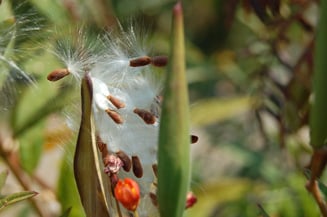

Contributor
- Topics: Archive, Inspired Gardens & Design, Plants You Need

As gardeners, we are naturally attracted to flowers and foliage. We know that most plants produce seeds and that they do so in an astonishing variety of ways. Few of us, however, plant strictly for the beauty of seed capsules. This article explores several candidates whose seedpods—defined here as a botanical structure that contains multiple seeds—might well be your garden’s next star attraction.
My research revealed a variety of unique and curious seed capsules. Organizing my list by form and structure gave me a way to talk about their appealing features as well as look at various methods of seed dispersal and protective devices that have evolved to optimize the success of a plant’s subsequent generations. While each of these seedpods is attractive, some of the following are beautiful, strange, or just plain fun.
Elongated pods

This form of seedpod is quite common in nature, beans and peas, of course, being the most familiar. But a plant whose seedpods look like blue sausages? Dorothy, I don’t think we’re in Kansas anymore. Decaisnea fargesii produces long, fat seedpods that are, well, shockingly blue. If the sausages description isn’t surreal enough for you, these seedpods are also commonly called dead man’s fingers. The tree is native to eastern Asia, where it gets to a modest 15 to 20 feet tall. Perhaps strangest of all, the jelly-like pulp surrounding the flat, black seeds within the pods is edible and is described as having a flavor similar to watermelon.

Many avid gardeners are familiar with the silk tree, Albizia julibrissin. Most people buy this tree for its delicate leaves and lovely pink, lightly fragrant flowers, but the thin, dangling seedpods that attractively showcase the seeds inside are an appealing feature as well. The seedpods of trumpet bush, such as Tecoma stans and T. ×smithii, are a bit more mundane. Though the eye-catching tubular flowers are the main show, the narrow, elongated seedpods that follow open to reveal curious, papery interiors decorated with seeds.

Fluffy filaments
Capsules filled with fluffy hairs attached to each seed are one of nature’s cleverest ways to disperse seed. Milkweed plants (Asclepias spp.), host plants for monarch caterpillars, are one example. Once the seed ripens, the capsule splits, releasing the airy filaments that carry the lightweight seeds on the slightest wind, which is exactly why milkweeds self-seed so successfully. Similar looking seedpods follow the beautiful, pale blue flowers of Tweedia caerulea, giving it the common name of blue milkweed. Like Asclepias, Tweedia is an effective self-seeder.
Explosive casting
While the above seedpods conjure images of lazy summer meadow days, the concept of a seedpod exploding is quite the opposite. Here, the seeds are too heavy to float away so this group of plants has devised a more violent solution. The ripe seed pods of Impatiens balfourii and I. basalmina, commonly called touch-me-not, burst at the slightest provocation, sending copious quantities of fertile seed as far as 30 feet.

Most people are familiar with love-in-a-mist (Nigella damascena) and its pretty seedpods. Ever notice what a prolific self-seeder this plant is? It, too, can throw its seeds once the dried capsule has burst. Castor bean (Ricinus communis) is famous for its curious, rubbery seedpods. As the seed capsule dries, it splits into three sections and forcibly ejects its highly toxic seed. Each seed has a caruncle, a nutritious warty appendage that attracts ants, which in turn help to spread the seed, a dispersal method termed myrmecochory.
Protective armor
Many plants produce seedpods with spiky, tough or woody shells to protect their maturing seed from an untimely attack from predators. Seeds need to mature to effectively propagate, and if a number of seedpods are eaten or otherwise harmed before maturation, this diminishes the plant’s odds of reproduction. Seed capsules of California native Fremontodendron californicum are tough and coated with bristled hairs. When conditions are right for germination, the seedpods crack open to reveal a cache of black seeds. Likewise, Datura produces a nut-like seedpod covered with hard nubs, which contains up to 100 seeds.

Many plants encase their seeds in woody capsules and one of the more interesting ones to me is honey myrtle (Melaleuca spp.). Native to Australia, these plants produce bottlebrush-like flowers that emerge from dark, cone-like buds. Once the flowers fade, these buds harden to rows of woody seed capsules that remain on the arching branches. This strategy allows specimens to withstand harsh conditions such as extreme drought, allowing the seed to eventually emerge in more favorable conditions.

Wafers and paper
Wafer-like seedpods are a less common means of seed dispersal but several of these are worthy of a painter’s palette. Start with the money plant (Lunaria annua). After flowering, plants produce wafer-thin, lime-green seedpods that ripen to papery silver, showcasing the half-dozen black seeds inside. Its common name owes to the seedpods bearing a striking resemblance to coins. Likewise, the little known Thysanocarpus radians produces—some would say features—delicate, flat, green seedpods edged prominently in pink. Totally charming and quite the surprise on an otherwise unobtrusive grassy plant, this seedpod has developed its own fan club.

Certain plants perform the neat trick of slowly unveiling their seed. Physalis alkekengi, better known as Chinese lanterns, produces papery orange husks that mature and degrade to a see-through lacy netting that reveals a fruit containing seeds within. Likewise, love-in-a-puff (Cardiospermum halicacabum) produces a lightweight, puffy seedpod that changes from green to red as the plant matures. Each dark seed within the seedpod is marked with a perfect cream-colored heart, inspiring some to call it the heartseed vine.
Final act
If we consider plants as being stars of their own play, then the formation and dispersal of seed is the final act before the curtain comes down (or the sequel appears). Appreciating the beauty and resilience of seed capsules only adds another layer of wonderment to our gardening experience.
Share:
Social Media
Garden Futurist Podcast
Most Popular
Videos
Topics
Related Posts

Low Maintenance Gardens – Better for Pollinators and People
Autumn 2022 “I come out every day. It’s therapy, my meditation.” Janet’s young garden transformed from overgrown, invasive plants to mostly natives. The dailiness of

Calochortophilia: A Californian’s Love Affair with a Genus
Summer 2022 I can chart the progression of my life by Calochortus. For the last two decades, at least. As a teenage girl growing up

Pacific Plant People: Carol Bornstein
Spring 2022 Public gardens play a key role in demonstrating naturalistic planting design, selecting native and adapted plants for habitat, and testing techniques for reducing

Add Year-Round Interest and Winter Blooms for Pollinators
Spring 2022 This article was created from an Interview by Merrill Jensen with Neil Bell in the Summer of 2021 for our Pacific Plant People









Responses